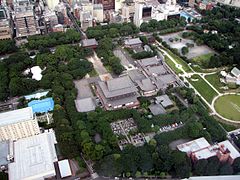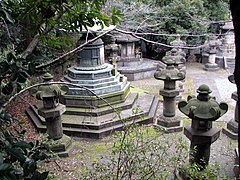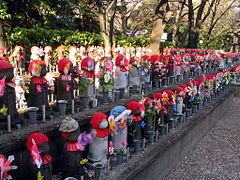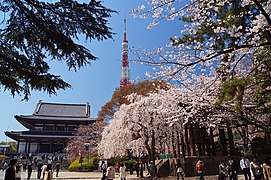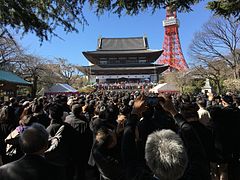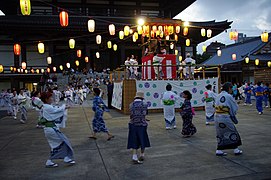Zōjō-ji



Zojo ( Jap. 増上寺 ) is a Buddhist temple in the district Shiba kōen in Minato in Tokyo , Japan . It was originally the great main temple of the Chinzai sect of Shingon-shu . The founder of the Zōjō-ji was Yūyo Shōsō ( 酉 誉 聖 聡 ). The mountain name ( sangō ) of the temple is San'en-zan ( 三 縁 山 ).
overview
Shūei ( 宗 叡 , 809–884), a student of Kūkai , founded a temple named Kōmyō-ji ( 光明 寺 ) in Kaizuka ( 貝 塚 ), today's Kōjimachi in Chiyoda ; this temple is said to have been the forerunner of the zōjō-ji. Centuries later, in 1393 during the Muromachi period during Yūyo Shōsō's lifetime, the temple converted from Shingon to Jōdo school.
During the Edo period , the temple served the Tokugawa as a family temple ( 菩提 寺 , bodaiji ). Tokugawa Ieyasu had the temple first relocated to Hibiya (district of Chiyoda ) before relocating it to its current location in 1598. In the Edo period there were 48 sub-temples and over 100 quarters for students. With the fall of the Tokugawa Shogunate , difficult times came for the temple, which suffered from the state-mandated revaluation of Shintoism at the expense of Buddhism. In addition, the main hall burned down in 1873 (and 1909). In 1873 the temple grounds were declared a park. But then in 1875 the leading politician Itō Hirobumi campaigned for the temple so that it could take off again.
A large part of the temple complex was destroyed by air raids during the Second World War , but most of the temple and its outbuildings were rebuilt. The northern part with the destroyed Tokugawa tombs was sold after the war. The Tokugawa urns were moved: they are now behind the main hall. The area east of the temple is called Shiba Daimon ( 芝 大門 , dt. "Great Shiba Gate"), because the gate (also 表 門 - Omote-mon ) is located there as access to the extensive facilities, today as a replica made of concrete. Today it stands on the street that leads directly to the temple, halfway from Hamamatsucho station .
Buildings
- The Sangedatsu Gate ( 三 解脱 門 , Sangedatsu-mon ) was built in 1622 and - like the sutras (see below) - survived the Second World War. The large two-story gate is classified as an important cultural asset . San ( 三 ) means three and Gedatsu ( 解脱 ) means Moksha . When a man walks through this gate he should find redemption from three ailments: tone ( 貪 , dt. Greed ), shin ( 瞋 , dt. Hate ) and chi ( 癡 , dt. Stupidity ).
- The sutras store ( 経 蔵 , kyōzō ), which is unusually large, was built in 1605. It is the oldest surviving structure in Tokyo, even if it is no longer entirely in its original form.
- The great hall ( 大殿 , Daiden ) was only rebuilt from concrete in 1974 and has features of both classic Buddhist construction and modern features.
- The Onarimon ( 御 成 門 ), the important gate on the northern side of the temple area facing the city, is now outside. The Onarimon metro station is very close.
- The temple's great bell ( daibonsho ) was completed in 1673 and is rung twice a day, six times in the morning and six in the evening. This should not only serve to announce the time, but also to spiritually purify people.
Aerial view of Tokyo Tower from
Jizō statues at the temple
Woodcut by Kawase Hasui
Tokugawa mausoleums
Six of the 15 Tokugawa shoguns are buried in Zōjō-ji:
- 2. Shogun Hidetada with his wife,
- 6. Shogun Ienobu with his wife,
- 7. Shogun Ietsugu ,
- 9. Shogun Ieshige ,
- 12. Shogun Ieyoshi and
- 14. Shogun Iemochi with his wife.
The tombs of Hidetada and the monument to his wife Sūgen'in , Ienobu and Ietsugu were declared national treasures, but were destroyed in World War II. The metal urns in the form of the compact Hōtō pagoda have been preserved. They are now positioned behind the main hall in a small fenced area. Only two gates to former tombs are preserved, they are no longer part of the temple district:
- Daitokuin Reibyō Somon (1632) ( 台 徳 院 霊 廟門 )
- Yushoin Reibyō Niten-mon (1717) ( 有 章 院 霊 廟 二天 門 )
Remarks
- ↑ In order to be able to distinguish temples of the same name according to their geographical location, a mountain name is given. This usually reads on a nearby mountain
- ↑ The Tokyo Prince Hotel is located there today.
- ↑ Another six shoguns are buried in Kan'ei-ji , two in Nikkō (Ieyasu and Iemitsu), the last shogun Tokugawa Yoshinobu in Tokyo Tokyo-Taninaka.
literature
- Tōkyō-to rekishi kyōiku kenkyū-kai (Ed.): Tōkyō-to no rekishi sampo (Vol. 2). Yamakawa Publishing, 2000, ISBN 4-634-29630-6 .
Web links
- Official website of the temple in Japanese and English
Coordinates: 35 ° 39 ′ 26.7 ″ N , 139 ° 44 ′ 54 ″ E

